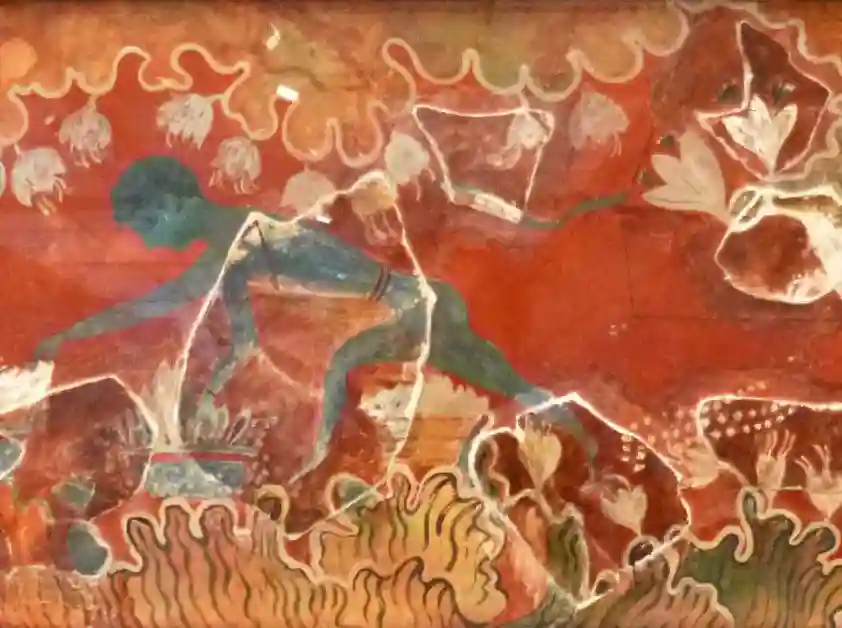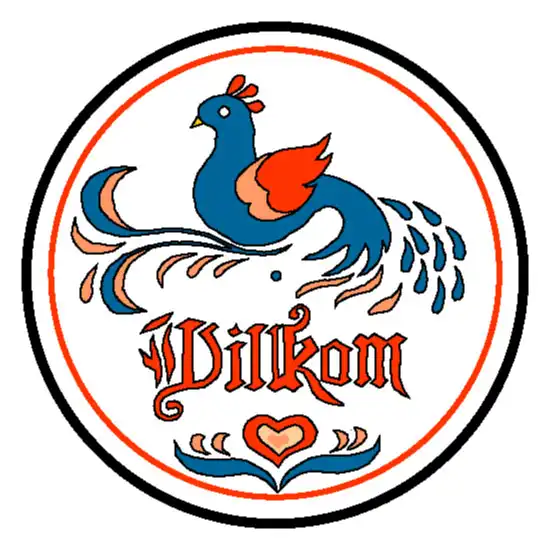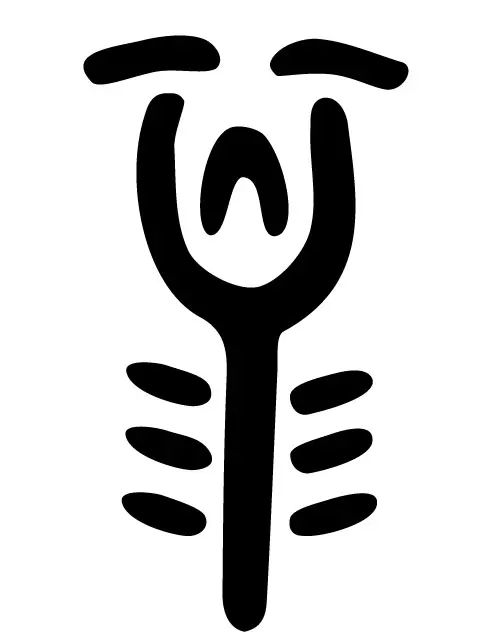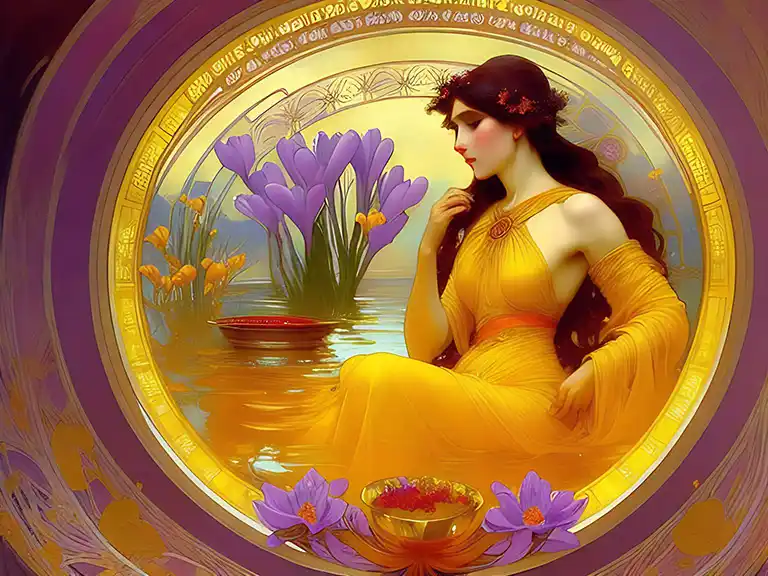The history of saffron
Saffron: a precious spice with a long history
Saffron is one of the most expensive spices in the world. It is made from the dried pistils of the saffron crocus, a flower native to the Middle East. But how did saffron originate and how was it used by ancient civilizations? In this article, we go back in time and discover the fascinating history of this golden spice.
The origin of the saffron crocus
The history of the saffron crocus is not entirely certain. Many people believe that Crocus sativus is a mutation of crocus Cartwrightianus, a crocus species that occurred wild in Greece at the time, and was selected and domesticated in Crete during the late Bronze Age. What is certain is that saffron cultivation is more than 4,000 years old.
Saffron in ancient Greece
The ancient Greeks used saffron for its aromatic properties and for its color properties. The majority of the population of ancient Greece had black hair, and because the favorite hair color was blond, they used yellow dyes to dye their hair. They used a mixture of saffron and potassium water.
In Greece, frescoes depicting the saffron harvest were also found, dating from 1600-1500 BC, such as the famous fresco in the palace of Knossos on the island of Crete.
Saffron in ancient Egypt
Saffron was also known to the ancient Egyptians. Pharaohs used saffron as a flavoring and as an aphrodisiac. Also, they used it to perfume their baths, houses and temples. In late Hellenistic Egypt, Cleopatra used saffron in her baths so that lovemaking would be even more pleasurable.
Saffron in ancient Persia
In ancient Persia, the cultivation of saffron expanded considerably. It was grown in Derbena and Isfahan in the 10th century BC. There, saffron threads had been discovered woven into ancient royal Persian carpets and shrouds.
Darius the Great of Persia (500 BC) ordered his governors to ensure that saffron crocus was planted in the far northern regions of the Persian Empire (in the Caucasus).
Because of its value, saffron has always been a symbol of wealth and elegance. The ruling classes of the ancient empires used it to add flavor to their food, to dye their robes and perfume their ballrooms. Saffron was also used by the ancient Persians as medicine, as an offering to the gods and as currency.
The spread of saffron around the world
Around 500 BC, saffron cultivation had also spread from Persia to eastern India. There, after Buddha's death, it was decided that the robes of the title class of Buddhist priests should forever be colored with saffron.
Later, Persian saffron was widely used by Alexander the Great and his troops during their campaigns through Asia. They drank saffron tea and ate rice colored with saffron.
Alexander himself used saffron mainly in his warm bath water, believing that the beneficial effects of saffron would heal his wounds sustained on the battlefield.
During 100 BC, saffron was also exported to China from Persia, along with cucumbers, onions, jasmine and vines. The Roman Empire, of course, also imported its saffron from Persia.
With the fall of the Roman Empire, saffron cultivation was introduced to Europe by the Moors, first in Spain and later in parts of France and southern Italy.
Saffron in Europe
During the Black Death period in Europe in the 14th century, the demand for saffron was skyrocketing. It was coveted by victims of the plague for medical purposes. Since many of the farmers able to grow saffron had also died of the Black Death, saffron was imported by ship from Mediterranean islands such as Rhodes. When one such shipload, worth €420,000 in today's money, was stolen by a group of nobles, a period of saffron piracy followed, resulting in the 14-week "Saffron War" and the establishment of Basel as a safe saffron production center that was also closer.
Later, the European production and trade center moved to Nuremberg, where the rampant counterfeiting of saffron led to the "Safranschou code. Under this law, saffron counterfeiters could be punished, imprisoned or even face the death penalty.  Saffron cultivation was introduced to England around 1350. The story goes that bulbs from the Levant, the historical-geographical name for part of southwest Asia, were smuggled into England in a special hollow of a pilgrim's staff. Saffron was initially grown only in monastery gardens for medical use. The light, well-drained calcareous soil and climatic conditions of northern Essex caused saffron cultivation to be concentrated in eastern England beginning in the 16th century. The town of "Cheppinge Walden" in Essex was renamed "Saffron Walden" because at the time it was located in the main saffron growing area and had become the saffron trading center of England.
Saffron cultivation was introduced to England around 1350. The story goes that bulbs from the Levant, the historical-geographical name for part of southwest Asia, were smuggled into England in a special hollow of a pilgrim's staff. Saffron was initially grown only in monastery gardens for medical use. The light, well-drained calcareous soil and climatic conditions of northern Essex caused saffron cultivation to be concentrated in eastern England beginning in the 16th century. The town of "Cheppinge Walden" in Essex was renamed "Saffron Walden" because at the time it was located in the main saffron growing area and had become the saffron trading center of England.
The introduction of saffron in America
Europeans introduced saffron to America when German and Swiss immigrants, members of the Schwenkfelder Kirche, left Europe with a bag full of saffron bulbs. Members of this church community had grown it widely in Europe. Beginning in 1730, saffron was grown throughout eastern Pennsylvania primarily by the Pennsylvania Dutch. Despite the name, the Pennsylvania Dutch are not of Dutch descent, but rather a corruption of the word "Deutsch," meaning German.
Spanish colonies in the Caribbean bought large quantities of this new American saffron, and the high demand caused the list price of saffron on the Philadelphia commodity exchange to equal that of gold. Later, trade with the Caribbean collapsed during the aftermath of the War of 1812, when many saffron exporting merchant ships were destroyed.
The etymology of saffron
The word "saffron" comes from the Latin word "Safranum" which derives via the ancient French term "safran" from the 13th century. "Safranum" in turn comes from the Persian زعفران (za'ferân). Some argue that it eventually came from the Arabic word زَعْفَرَان (za'farān), which is itself derived from the adjective أَصْفَر (asfar, "yellow"). However, some linguists claim that زعفران (Za'faran) is the Arabic form of the Persian word زرپران (zarparān) - "with yellow leaves." Latin "Safranum" is also the source of Italian "Zafferano", Portuguese "Açafrão" and Spanish "Azafrán" etc.
The name of the genus 'crocus' is derived from the Greek word κρόκος (krokos). This in turn is a loan word from a Semitic language, related to the Hebrew word כרכום (Karkom), the Aramaic word ܟܟܘܪܟܟܡܡܐ (kurkama) and the Arabic كركم (Kurkum). These words in turn can be traced from the word कुङ्कुमं (kunkumam) from Classical Sanskrit meaning "saffron" or "saffron yellow."
Sativus is a Latin botanical adjective and means "cultivated."
Saffron in mythology
Saffron has been mentioned in many ancient mythologies and has a long history of use in various cultures. In Greek mythology, saffron is said to have been first used by the god Hermes to cure his injuries. It is also said to have been used by the goddess Aphrodite in her bath to enhance her beauty.
In Hindu mythology, saffron is associated with Lord Vishnu and is believed to symbolize purity, courage, and sacrifice. It is also used in various religious ceremonies and rituals.
In Persian mythology, saffron is believed to have been created from the tears of the legendary hero Kaveh, who led a revolt against an evil king. It is also said to have been used by the goddess Anahita to heal the sick and the wounded.
In ancient Egyptian mythology, saffron was used in medicine and was believed to have healing powers. It was also used in perfumes, cosmetics, and other beauty products.
Saffron also appears in the Bible, where it is referenced as a valuable spice. In the Song of Solomon, the bridegroom praises his bride's lips as being like a thread of scarlet, which some scholars interpret as a reference to saffron.
Overall, saffron has been highly valued throughout history and has been associated with various spiritual, cultural, and medicinal properties. Its mention in mythology further reflects its importance and significance in different cultures.
Conclusion
Saffron has a rich and extensive history dating back several millennia. Once a luxury product affordable only to the wealthy, today it is widely used in dishes and medicinal applications around the world.
The Crocus sativus is a sterile triploid that can only reproduce through its tubers/bulbs, making it very likely that it is one of the oldest cultivated flower bulb species. Therefore, it is interesting to consider that the Crocus sativus bulbs available from our company have the same properties as the bulbs cultivated long ago in ancient Greece.






















 BIO bulbs
BIO bulbs
 NON-BIO bulbs
NON-BIO bulbs
 Wholesale
Wholesale
 Miscellaneous flower bulbs
Miscellaneous flower bulbs





